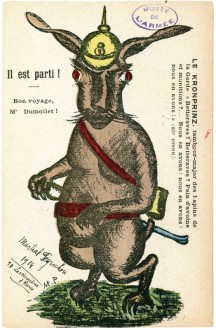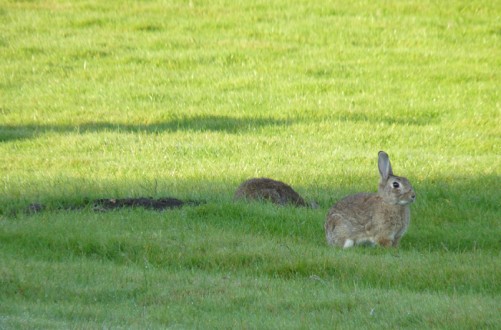
The Captain will dine. Lithograph by Englemann from a drawing by Louis Albert Guislain Bacler d’Albe © Paris, musée de l’Armée, Dist. RMN-GP / Émilie Cambier
This lithograph shows an old soldier holding a rabbit. On his left, soldiers are resting in a tent; in the back scene other soldiers are hunting for their food. This engraving illustrates one aspect of the soldiers’ life in the field, the bivouac. In the field, when rations were not forthcoming, soldiers resorted to plundering local villages for food in order to provide for themselves.
Header of French trench newspaper “Le Lapin à plumes”. From the end of 1914, with the war of position, defensive trenches were dug by the soldiers where they lived and fought. In order to escape from their daily lives, they started editing “trench newspapers”. The “Lapin à Plumes” was the illustrated supplement of the “Canard Poilu”, a “corrosive, anti-Boche weekly newspaper from the Front” the official body of the Poilus of the 15th Corps. 32 issues were published between October 1914 and May 1916. French cartoonist Marcel Jeanjean (1893-1973) drew all the page headers. They featured the Poilus transformed into rabbits seen performing different activities: fighting in the trenches (№1 & 5), cooking (№8), engaged in attack (№11), on the telephone (№19) and in the infirmary (№20). Should they be French or German, all the soldiers were represented as rabbits, as seen in № 17 featuring German prisoners. Other animals living in dug holes or digging the earth, such as the mole or the badger, are also used to identify or represent the soldier in the trenches © Paris, musée de l’Armée
The Kronprinz as Drum Major of the Rabbits of the Guard. French postcard by Martial Peyrichou, 1914. French political satire postcard that depicts the son of the German emperor: Crown Prince Wilhelm as Drum Major of the Rabbits of the Guard wearing a spiked helmet. This postcard probably refers to his military training in the Garde-Regiment zu Fuß. During the Great War, the Kronprintz was named commander of the V Army. He is best remembered for his frivolous lifestyle that earned him the nickname of “Clown Prince” in the British press. The nickname was used in several French satirical magazines such as La Baïonnette in its edition of 22 June 1915 that featured him riding a white rabbit named Clown Printz. Was it an allusion to one of the personality traits of the rabbit that decamps each time he hears an unfamiliar noise? © Paris, musée de l’Armée
The Rabbit & The Hare
“The trembling fools! They take me
for the very thunderbolt of war!”
Jean de La Fontaine The Hare and the Frogs.
Cunicularii
The Romans used the symbol of the rabbit and named their sappers and miners: munitores, fossores, fodientes or cunicularii. The Latin term cuniculus, meaning “rabbit”, refers to the tunnelling used as an offensive weapon in siege warfare.
In his Chronicles, many years later, Jean Froissart quoted an episode of the Hundred Years’ War, which took place between King Philip VI of Valois and King Edward of England in 1339, during the so-called Battle of Buironfosse. Before the fighting, as knighthood was conferred on many esquires, a great shouting was raised by the French due to a hare that had sprung up in the lines, causing alarm amongst the ranks. Finally, there was no fighting and the new knights were dubbed “Knights of the Hare”.
Rabbit Fur
Rabbit fur is used to make warm and windproof clothing such as overcoats. At the end of the Second World War, Sigrid Schultz (1893-1980), a Chicago Tribune Berlin correspondent, acquired an album documenting the so-called “Angora Project” while assisting the American Counter Intelligence Corps in the search for documents missing from in Himmler’s Alpine villa. Heinrich Himmler (1900-1945) launched the “Angora Project” in 1941, in order to breed Angora rabbits for their warm and soft wool to make clothes for several branches of the German military. Specialists were incorporated into special canine sections called Reichsfachgruppen Kaninchenzüchter to provide the Angora Rabbits with veterinary care and controlled diet. By 1943, the “Angora Project” consisted of some 65 000 rabbits, all bred in special hutches in different concentration camps all throughout the Reich, with a production of 5 tons of wool per year. Nowadays, the “Angora Rabbit Raising in Nazi Concentration Camps” photo album is housed at the collections of the Wisconsin Historical Society.
Rabbits at the Invalides
During the Second World War, French civil servant with the National Office for Veterans and Victims of War (ONAC) Georges Morin, his spouse Denise and daughter Yvette lived in the Hotel des Invalides. In 1940, he and this family joined the French Resistance Movement Action Vengeance de la France Combattante. From 1942 to 1944, the Morin hid Allied pilots from the RAF, the RCAF and US Air Force inside the Hotel des Invalides, prior to their transfer with false documents to either Spain or Britain. The pilots ended up nicknaming Denise “Mammy Rabbit” because she was raising rabbits in order to feed them. On 5 July 1944, following denunciation, the Morin Family was arrested by the Gestapo and deported to Buchenwald concentration camp, where the members were separated in order to be sent to two different camps: George was sent to Mittelbau-Dora while Denise and her daughter Yvette to Ravensbrück. Nowadays, a commemorative plaque with George’s name inscribed on it can be seen in the Hotel des Invalides.
Even now, wild rabbits can be seen coming in and out of their holes in the gardens located on the northern façade of the Hotel.





Ajouter un commentaire